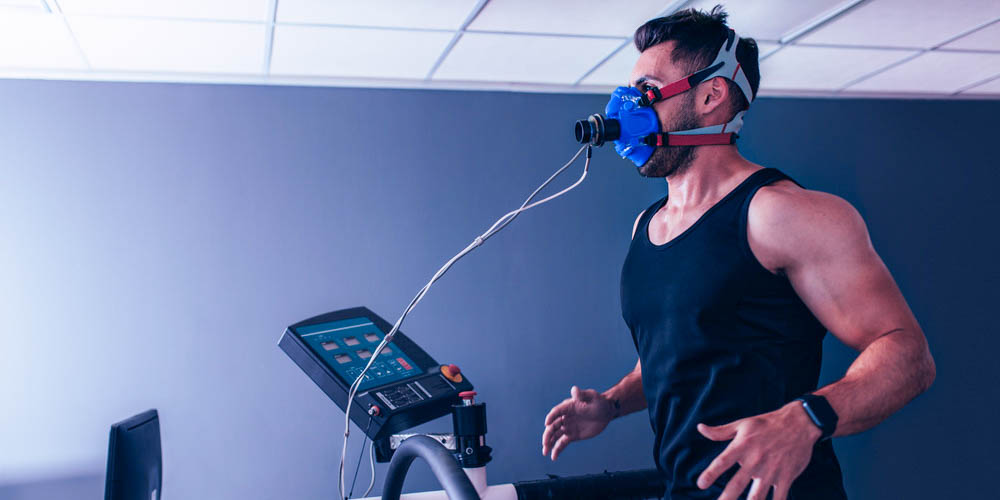If you know your aerobic and anaerobic thresholds, you will train more efficiently and more targeted. If you are stagnating in your training, at the latest, you should deal with this.
 Fabian Stähli, MSc Sport and Exercise ETH, Physiotherapist HF, Head of Performance Diagnostics Medbase Luzern Allmend
Fabian Stähli, MSc Sport and Exercise ETH, Physiotherapist HF, Head of Performance Diagnostics Medbase Luzern Allmend
Many triathletes have ambitious goals but little time. Consequently, they want to use the limited training time as efficiently as possible. Assuming that “hard” training makes you faster, amateurs in particular often move in the aerobic-anaerobic transition zone. This is efficient at first, and aerobic performance increases quickly.
Soon, however, there is a “ceiling effect” and no further progress is made. This is one of the reasons why athletes should know their aerobic and anaerobic thresholds. The other is that it allows for much more targeted training.
Beyond the anaerobic threshold, fat burning is zero
In the aerobic zone you train to provide energy primarily from fat burning. Your muscles are still sufficiently supplied with oxygen in this range. Fat burning decreases in the transition zone between the aerobic and anaerobic thresholds; now carbohydrates are metabolised more.
As soon as you cross your anaerobic threshold, fat burning is zero. Your muscles are no longer sufficiently supplied with oxygen in the anaerobic zone, there is an increasing “oxygen debt” and the formation of lactate (lactic acid).
The anaerobic threshold is not a precisely defined point, but a physiological range in which energy supply gradually changes from the aerobic to the anaerobic range. On average, it is lower in women than in men. The reasons are generally lower oxygen uptake, lower testosterone levels and smaller muscle percentage than in men.
Triathletes who train a lot above the anaerobic threshold also (unintentionally) train the formation of lactate in their muscles (anaerobic glycolysis).
Do not train too intensively
With the right training – a lot in the aerobic zone, little beyond the anaerobic threshold and, if possible, no intervals that are too intense – it is possible to “re-polarise” the fast muscle fibres so that they produce less lactate. This principle applies to the majority of endurance athletes.
The individual training zones derive from the power/running speed at your anaerobic threshold. In addition, the heart rate and the subjective feeling of exertion can be used. With these three parameters you get a “triangle” for load control.
The five training zones
The zones are typically defined based on measurements such as heart rate, power (watts) or speed. Below are the heart rate zones at the anaerobic threshold:
- Z1 – Compensation/recovery zone : <68% of HR at anaerobic thresholds.
- Z2 – Basic endurance zone : 56 to 75% of HR at anaerobic thresholds
- Z3 – Upper endurance zone : 84 to 94% of HR at anaerobic thresholds
- Z4 – Threshold zone : 95 to 105% of HR at anaerobic thresholds
- Z5 – Power zone : >106% of HR at anaerobic thresholds
Knowing the training zones is important to design your training optimally. Find out how they are calculated in 2PEAK.
The different tests
There are a number of methods and evaluations to determine the thresholds:
THE “FTP” TEST
Popular in cycling/triathlon for some time now is the “FTP” test (FunctionalThreshold Power-Test), which is performed under real conditions “in the field”. You need to have a good feeling for pacing, because in this test you have to ride your bike for 20 minutes as evenly as possible on a flat track. A power meter on the bike measures your power in watts and calculates the average value. With the help of a formula, you can calculate your “functionalthreshold power”.
However, the “FTP” has two problems: If your pacing isn’t right, you won’t be able to perform relatively evenly over the 20 minutes – or you won’t be using your full potential.
In addition, the conversion formula of this test does not take into account individual physiology. The calculation formula for the “FTP” includes a flat correction of five percent. However, it can be as little as two percent or as much as ten percent for individual people. This should be taken into account when interpreting the “FTP”.
SPIROERGOMETRY
The test person wears a face mask on the treadmill or bicycle ergometer, which measures the oxygen uptake and carbon dioxide release with each breath. The ratio of oxygen uptake to carbon dioxide release can be used to determine when fat burning is at its maximum and whether the test person is still running or cycling in the aerobic range or already in the anaerobic range. If the metabolism is more anaerobic, then more carbon dioxide is exhaled.
Spiroergometry determines at which power/speed and corresponding heart rate the ventilatory threshold VT1 or the ventilatory threshold VT2 is reached. Up to VT1 you run in the basic endurance zone. VT1 is the gradual transition from aerobic to anaerobic work in the muscle. VT2 corresponds more or less to the anaerobic threshold from lactate diagnostics.
Spiroergometry is available in two variants: As a ramp test, in which the load increases gradually without steps according to a given protocol, or as a step test, in which the “interrogated line” is increased step by step. In both variants, the load intensity is increased more and more until you have reached the maximum load towards the end of the test.
Performance test at Medbase
The sports scientists and sports physicians at Medbase check your performance level with an endurance test. Based on this, they explain to you in a clear and uncomplicated way how you can optimally incorporate the results into your training.
Book now
THE LACTATE LEVEL TEST
The lactate level test, on the other hand, requires a level protocol with level durations of three to five minutes so that the lactate concentration measured in the blood can settle at the current level. Here, too, the intensity of the load is increased more and more until you have reached the maximum load towards the end of the test.
At regular intervals (every 3 to 5 minutes), the lactate in the blood is determined using a blood drop from the earlobe.
The pulse values and the lactate values can be used to determine when you switch from the aerobic to the anaerobic training zone. The terms “anaerobic” and “aerobic” threshold are originally terms from lactate diagnostics.
Well-trained endurance athletes have lower lactate values than poorly trained people because their muscles produce less lactate and their bodies can remove and recycle the lactate better. For them, lactate production increases only slowly during the test. Only shortly before reaching the anaerobic threshold does it begin to rise sharply. In poorly trained individuals, on the other hand, lactate production increases sharply some time before the anaerobic threshold is reached.
For the lactate level test, you should ideally do your main sport. It is usually done on a treadmill or bicycle ergometer, less often on a swimmer’s or rower’s ergometer.
The most accurate test is the maximum lactate steady-state test, abbreviated to “MLSS”. However, it can only be used under research conditions because the test person has to come to the laboratory several times.
2PEAK offers various simple but effective methods for measuring performance under real conditions, which can be repeated as often as necessary. Here is an overview of the most important performance tests offered for cycling, running and swimming.
Training with the help of the Borg scale
Athletes with good body awareness and several years of training often do well with the “Borg scale”, named after the Swedish physiologist Gunnar Borg. For such experienced endurance athletes, it is a good measure of how they feel under stress. The lowest value of six corresponds to no exertion, the highest of twenty is the exertion at which the athlete gives the maximum possible. Training without a heart rate monitor can help you to get a better feel for your body.
Pay attention to carbohydrate intake
The carbohydrate stores in the muscles (glycogen stores) are depleted relatively quickly during intense exercise at or above the anaerobic threshold. You need carbohydrates to maintain maximum performance – but this amount cannot be increased at will. In extreme cases, a periodic carbohydrate intake of up to 120 grams per hour is still tolerable, but many people experience digestive problems even with smaller amounts and are therefore no longer able to perform at full capacity.
Conclusion
The goal of endurance training is to improve your performance or speed at the anaerobic threshold. This is achieved by improving the maximum oxygen uptake and by improving the fat metabolism and reducing the lactate formation rate.
Who is Medbase?
Medbase is the largest multidisciplinary sports medicine network in Switzerland and offers specialised sports medicine services for athletes, clubs and sports associations of all activity levels in the areas of sports medicine, sports physiotherapy, performance diagnostics and training advice.

